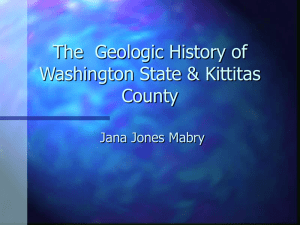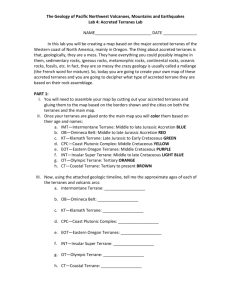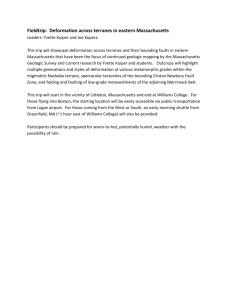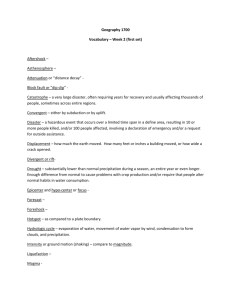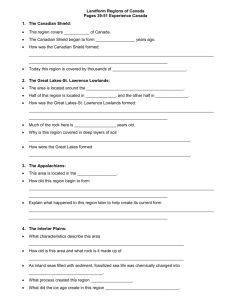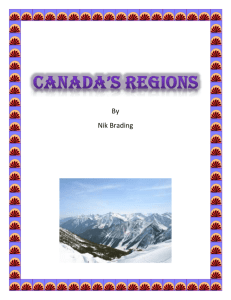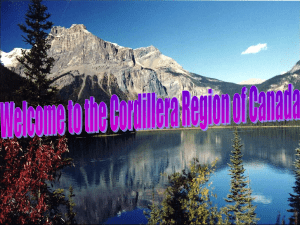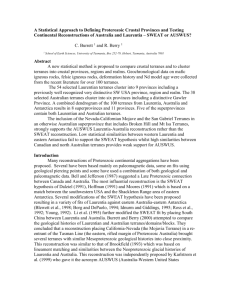Student handout for Exercise on the Mesozoic
advertisement
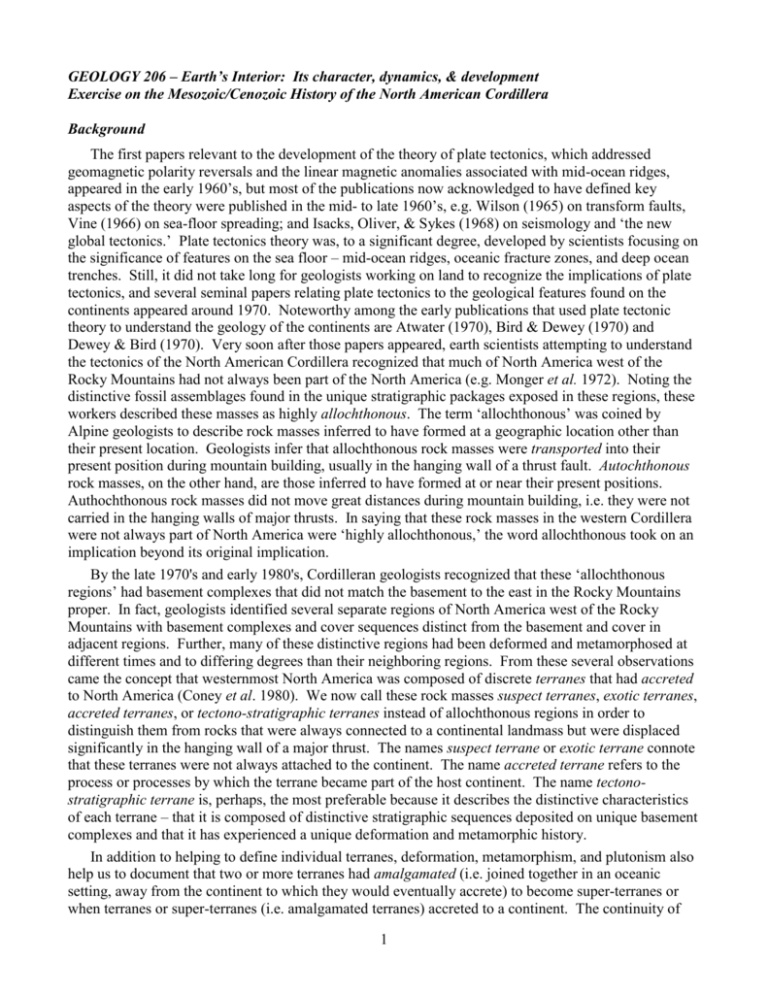
GEOLOGY 206 – Earth’s Interior: Its character, dynamics, & development Exercise on the Mesozoic/Cenozoic History of the North American Cordillera Background The first papers relevant to the development of the theory of plate tectonics, which addressed geomagnetic polarity reversals and the linear magnetic anomalies associated with mid-ocean ridges, appeared in the early 1960’s, but most of the publications now acknowledged to have defined key aspects of the theory were published in the mid- to late 1960’s, e.g. Wilson (1965) on transform faults, Vine (1966) on sea-floor spreading; and Isacks, Oliver, & Sykes (1968) on seismology and ‘the new global tectonics.’ Plate tectonics theory was, to a significant degree, developed by scientists focusing on the significance of features on the sea floor – mid-ocean ridges, oceanic fracture zones, and deep ocean trenches. Still, it did not take long for geologists working on land to recognize the implications of plate tectonics, and several seminal papers relating plate tectonics to the geological features found on the continents appeared around 1970. Noteworthy among the early publications that used plate tectonic theory to understand the geology of the continents are Atwater (1970), Bird & Dewey (1970) and Dewey & Bird (1970). Very soon after those papers appeared, earth scientists attempting to understand the tectonics of the North American Cordillera recognized that much of North America west of the Rocky Mountains had not always been part of the North America (e.g. Monger et al. 1972). Noting the distinctive fossil assemblages found in the unique stratigraphic packages exposed in these regions, these workers described these masses as highly allochthonous. The term ‘allochthonous’ was coined by Alpine geologists to describe rock masses inferred to have formed at a geographic location other than their present location. Geologists infer that allochthonous rock masses were transported into their present position during mountain building, usually in the hanging wall of a thrust fault. Autochthonous rock masses, on the other hand, are those inferred to have formed at or near their present positions. Authochthonous rock masses did not move great distances during mountain building, i.e. they were not carried in the hanging walls of major thrusts. In saying that these rock masses in the western Cordillera were not always part of North America were ‘highly allochthonous,’ the word allochthonous took on an implication beyond its original implication. By the late 1970's and early 1980's, Cordilleran geologists recognized that these ‘allochthonous regions’ had basement complexes that did not match the basement to the east in the Rocky Mountains proper. In fact, geologists identified several separate regions of North America west of the Rocky Mountains with basement complexes and cover sequences distinct from the basement and cover in adjacent regions. Further, many of these distinctive regions had been deformed and metamorphosed at different times and to differing degrees than their neighboring regions. From these several observations came the concept that westernmost North America was composed of discrete terranes that had accreted to North America (Coney et al. 1980). We now call these rock masses suspect terranes, exotic terranes, accreted terranes, or tectono-stratigraphic terranes instead of allochthonous regions in order to distinguish them from rocks that were always connected to a continental landmass but were displaced significantly in the hanging wall of a major thrust. The names suspect terrane or exotic terrane connote that these terranes were not always attached to the continent. The name accreted terrane refers to the process or processes by which the terrane became part of the host continent. The name tectonostratigraphic terrane is, perhaps, the most preferable because it describes the distinctive characteristics of each terrane – that it is composed of distinctive stratigraphic sequences deposited on unique basement complexes and that it has experienced a unique deformation and metamorphic history. In addition to helping to define individual terranes, deformation, metamorphism, and plutonism also help us to document that two or more terranes had amalgamated (i.e. joined together in an oceanic setting, away from the continent to which they would eventually accrete) to become super-terranes or when terranes or super-terranes (i.e. amalgamated terranes) accreted to a continent. The continuity of 1 structural elements such as major faults or consistently oriented folds and fabrics across terrane boundaries, the correlation of metamorphic events with comparable ages and metamorphic grades on both sides of a terrane boundary, or the existence of a single, continuous unconformity across a terrane boundary indicates that the formerly distinct rock masses were joined at the time of deformation, metamorphism, or uplift and erosion. Likewise, we sometimes find stitching plutons, igneous intrusions that cut through two or more terranes at the same time and ‘stitch’ them together. Under ideal circumstances, the boundaries between terranes are major fault zones within or across which we can measure offsets of known sense and magnitude. Likewise, ideally there exist data supporting the separation between individual tectono-stratigraphic terranes and the continent to which they are accreted – such as distinctive fossil assemblages within rocks of comparable ages, paleogeographic data consistent with different paleolatitudes for rocks of comparable ages, or paleomagnetic data indicating different paleolatitudes for rocks of comparable ages. Paleomagnetic data are particularly useful; thermal or detrital remanent magnetism from units of the same age on different terranes and on the continent might yield different apparent geomagnetic pole positions. These data might indicate that the continent and the terranes were at different paleolatitudes at one time or that the different masses had different orientations relative to their present orientations at some time in the past. Such paleomagnetic do not always exist, or if the paleomagnetic data exist they are difficult to interpret because the terranes and the continent could have been separated but have been at similar paleolatitudes, because diagenetic processes or deformation have altered the original detrital or thermal remanent magnetic signal, or because deformation and metamorphism have obscured or obliterated the detrital or thermal remanent magnetism. References: Atwater, T. 1970. Implications of plate tectonics for the Cenozoic tectonic evolution of western North America. Geological Society of America Bulletin 81, 3513-3536 Bird, J. M. & Dewey, J. F. 1970. Lithosphere plate-continental margin tectonics and the evolution of the Appalachian orogen. Geological Society of America Bulletin 81, 1031-1069. Coney, P. J., Jones, D. L. & Monger, J. W. H. 1980. Cordilleran suspect terranes. Nature 288, 329-333. Dewey, J. F. & Bird, J. M. 1970. Mountain belts and the new global tectonics. Journal of Geophysical Research 75, 2625-2647. Isacks, B., Oliver, J., & Sykes, L. R. 1968. Seismology and the new global tectonics. Journal of Geophysical Research 73, 5855-5899. Monger, J. W. H., Souther, J. G. & Gabrielse, H. 1972. Evolution of the Canadian Cordillera: A plate tectonic model. American Journal of Science 272, 577-602. Vine, F. J. 1966. Spreading of the ocean floor: New evidence. Science 154, 1405-1415. Wilson, J. T. 1965. A new class of faults and their bearing on continental drift. Nature 207, 343-347. The Focus of this Exercise For this exercise, you will examine two transects across the North American Cordillera near the Canada-US border (in publications focused on the Canadian portion of the Cordillera, this area is often called the ‘Southern Cordillera’ though for those of us living south of the international border this area is to our north). Information on the general geology, geophysical characteristics, geochronology, structure, and tectonics along the transects was compiled in the mid- to late-1980s as two of many ContinentOcean Transects constructed for the Decade of North American Geology and contemporaneous centennial of the Geological Society of America. The two transects used here are the Centennial Continent-Ocean Transect #7, B-2 Juan de Fuca Plate to Alberta Plains and the Centennial ContinentOcean Transect #9, B-3 Juan de Fuca Spreading Ridge to Montana Thrust Belt. Each Transect contains 2 • a map or maps depicting the geology within a strip that is approximately 60-80 km wide and extends from the craton to the ocean • a cross section showing the ages and contact relationships for near surface rocks within the strip • magnetic and gravity profiles along the transect • a profile ~50 km deep derived from seismic reflection and refraction data and gravity measurements • an interpretative section that depicts the structures to a depth of approximately 50 km beneath the surface. You will also find • find color-coded chronostratigraphic columns, which plot the different rock types in a column whose vertical scale corresponds to the ages of the rock types • diagrams that compile different rock types into ‘tectonic kindreds,’ that is define which rock types occur together in particular tectonic settings • tectono-stratigraphic flow charts, which show changes in tectonic affinity for rock assemblages found at one location in the transect and which define the timing of major faulting or terrane accretion. The diagrams in the transects are intended to highlight the differences between different terranes by showing that: (1) different terranes have different basement and cover sequences, and (2) different terranes experience deformation types of deformation and metamorphism at different times. As noted above, we can use patterns of deformation and metamorphism, extent and timing of unconformities, and timing and composition plutonism to document when terranes amalgamated or accreted to North America. In addition to the two transects, I recommend that you look through one the papers below, which discuss the general tectonic history of this portion of the Cordillera (I have posted PDFs of these articles to BlackBoard): Dickinson, W. R. T. 2004. Evolution of the North American Cordillera. Annual Reviews of Earth and Planetary Science 32, 13-45. Johnston, S. T., 2008. The Cordilleran Ribbon Continent of North America. Annual Reviews of Earth and Planetary Science 36, 495-530 (the supplemental material for this paper presents a particularly good but short summary of the tectonics). Simony, P. & Carr, S. D. 2011. Cretaceous to Eocene evolution of the southeastern Canadian Cordillera: Continuity of Rocky Mountain thrust systems with zones of “in-sequence” midcrustal flow. Journal of Structural Geology 33, 1417-1434. Looking through at least one of the papers listed below should help you get a feel for more up-to-date information on the structure of the lower crust and upper mantle in the area of the two continent-ocean transects: Bostock, M. G. & VanDecar, J. C. 1994. Upper mantle structure of the northern Cascadia subduction zone. Canadian Journal of Earth Sciences 32, 1-12. Bostock, M. G., Eaton, D. W., & Snyder, D. B. 2010. Teleseismic studies of the Canadian landmass: Lithoprobe and its legacy. Canadian Journal of Earth Sciences 47, 445-461. Clowes, R. M., White, D. M., & Hajnal, Z. 2010. Mantle heterogeneities and their significance: results from Lithoprobe seismic reflection studies and refraction-wide angle reflection studies. Canadian Journal of Earth Sciences 47, 409-443. 3 Cook, F. A., Clowes, R. M., Snyder, D. B., van der Velden, A. J., Hall, K. W., Erdmer, P., & Evenchick, C. A. 2002. Precambrian crust beneath the Mesozoic northern Canadian Cordillera discovered by Lithoprobe seismic reflection profiling. Tectonics 23, 1-28. Hyndman, R. D. 2010. The consequences of Canadian Cordillera thermal regime in recent tectonics and elevation: a review. Canadian Journal of Earth Sciences 47, 621-632. Mercier, J.-P., Bostock, M. G., Cassidy, J. F., Dueker, K., Gaherty, J. B., Garnero, E. J., Ravenaugh, J. & Zandt, G. 2009. Body-wave tomography of western Canada. Tectonophysics 475, 480-492. Snyder, D. B., Clowes, R. M., Cook, F. A., Erdmer, P., Evenchick, C. A., van der Velden, A. J., & Hall, K. W. 2002. Proterozoic prism arrests suspect terranes: Insights into the ancient Cordilleran margin from seismic reflection data. GSA Today 12, 4-10. Zelt, C. A., Sain, K., Naumenko, J. V. & Sawyer, D. S. 2003. Assessment of crustal velocity models using seismic refraction and reflection tomography. Geophysical Journal International 153, 609-626. Having an idea of the lower crust and upper mantle structure will help to provide some insight to the kind of tectonic processes responsible for forming the Cordillera. I have posted PDFs of the articles listed above to BlackBoard. Your task: To answer the five questions below. I recommend that you try to answer each question with three-fourths of a page to one full page of text (double-spaced and with 12 point font). It may be possible to answer the questions fully in a shorter essay, and longer answers may enable you to address points in greater detail. Still, the one page of text gives you an idea of the level of detail I anticipate from you. If you do write a longer answer, take care not to wander off point. In writing your answers, you may use your notes, the posted PDFs of my lecture PowerPoints, the text, the published pamphlets accompanying the two Transects, the papers listed above, or any other sources you find. In addition, I encourage you to share any information you glean about the geology and tectonic evolution of these areas with others in the class. I only ask that you acknowledge the sources of ideas you use in your answers, especially those you have learned from your classmates. 1. At the west end of the transects is the modern North America-Juan de Fuca plate boundary. Citing specific structures or crustal elements in the transects or geophysical studies of the upper mantle, outline whether you think this is a compressing, extending, or neutral subduction zone (see chapter 9, section 9.6 in of your text and PDFs of lectures 9 and 21). Do you think that the character of the modern subduction zone is a good or poor indicator of the character of the convergent plate boundary along the western margin of the North American at other times during the Cenozoic and Mesozoic? 2. Accretionary wedges are regularly associated with subduction zones (see chapter 9 in your text and lectures 22, 23 and 24). At the present time, there are Tertiary and Holocene accretionary wedges at the west end of the Cordillera (see Cross Section II on sheet 1 of Transect B2 or Cross Sections A and B on Sheet 1 of Transect B3). If subduction was the process by which the different tectonostratigraphic terranes were attached to North America, would there have been accretionary wedges associated with those subduction zones? If so, where are the rocks that composed those accretionary wedges? 3. In what ways does the Cordillera differ from belts created by the collision of two continents – does it have different structures, different types of metamorphism, different types of sedimentary 4 sequences, etc.? In what ways does the Cordillera resemble belts created by the collision of two continents? Chapter 10, sections 10.4 and 10.6 in your text and the topics addressed during the final two weeks of class will provide some relevant information here. 4. What do you predict would happen to the Cordillera if the subducting Juan de Fuca plate oceanic crust eventually brought a continent landmass into the subduction zone? 5. Compared to the structure of continental strike-slip faults as discussed earlier in the semester (see chapter 8, sections 8.2 to 8.5 and lectures 17 to 21), do you find the representations of the Chewack-Pasayten, Ross Lake, and San Juan strike-slip faults accurate? What is the role of these strike-slip faults in terrane accretion? What effects, if any, do these faults have on terranes or major tectonic boundaries to the east or west? Some questions that might direct your map observations: i. Examine the east end of the Transect B-2 Juan de Fuca Plate to Alberta Plains. What is the character and age of the basement (Pl1) beneath the Alberta Plains and Rocky Mountain Belt. What observations would induce Monger et al. to infer that Pl1 exists beneath the Omineca Crystalline Belt west of the Rocky Mountain Belt? How do Pl2 units relate to the Pl1 units? What is (are) the correlative unit(s) in the Transect B-3 Juan de Fuca Spreading Ridge to Montana Thrust Belt sections that correlate to Pl1 and Pl2? ii. Geophysical data from Transect B-2 Juan de Fuca Plate to Alberta Plains indicate that the Moho rises abruptly beneath the boundary between the Rocky Mountains and the Omineca Crystalline Belt (this is also apparent in the figures in Zelt et al.). How do Monger et al. interpret this change in the depth of the Moho? Is there a comparable structure apparent on the Transect B-3 Juan de Fuca Spreading Ridge to Montana Thrust Belt sections? iii. What is the relationship between the westward extent of Proterozoic North America on Transect B-2 Juan de Fuca Plate to Alberta Plains and the present deep structure of the part of the Cordillera? On section AA’ on Transect B-3 Juan de Fuca Spreading Ridge to Montana Thrust Belt, Cowan & Potter argue that the Chewack-Pasayten fault coincides with the inferred edge of Proterozoic North America. When do you think it became active? Do you think that this fault marked the original western boundary of North America prior to the formation of the North American Cordillera? iv. In what tectonic settings did the cover strata exposed in the Alberta Plains and Rocky Mountains on Transect B-2 Juan de Fuca Plate to Alberta Plains accumulate? What tectonic setting would you infer for the cover strata exposed in the vicinity of Glacier National Park on Transect B-3 Juan de Fuca Spreading Ridge to Montana Thrust Belt? v. What is the sense of movement on thrust faults in Canadian Rocky Mountains and correlative settings in the U.S.? vi. What is the tectonic affinity of rocks in the Kootenay terrane (unit KO), found above the Monashee Decollement? Compare the sense of offset on the Monashee Decollement with the sense of offset on faults in the Rocky Mountains? Given its tectonic history and its stratigraphy, 5 do you interpret the Kootenay terrane to be a distinctive tectono-stratigraphic terrane? If so, when did it accrete to North America? vii. What are the oldest rock units found in the Cache Creek terrane (unit CC)? What is the tectonic affinity of these rocks? What was the tectonic setting of the Rocky Mountains and Alberta Plains at the time that these Cache Creek rocks were forming? viii. How would you describe the boundaries between distinctive terranes within the Intermontane Belt and Coast Plutonic Complex. What features and rock types would you expect to see in an exposure of one of these boundaries? What do you make of the predominance of west-dipping contacts within and between units in the Intermontane Belt and Coast Plutonic Complex? ix. What constraints are there on the timing of the amalgamation of terranes within the Intermontane Belt? In the Coast Plutonic Complex? x. In what ways do the constituents of the Insular Belt differ from those in the Coast Plutonic Complex and Intermontane Belt? Does the sense of movement on faults within the Insular Belt match the sense of movement seen on faults to the east? What do these observations tell you about how the timing and tectonic setting in which Insular Belt was constructed? How and when did it dock with the Coast Plutonic Complex? xi. Cowan & Potter indicate that the San Juan Islands and the Cascades are underlain by sialic, continental basement. How does that basement correlate to the basement at the east end of the transects? How does that basement correlate to the basement seen in the Coast Plutonic Complex and Insular Belt to the north? Are there any similarities between the San Juan Islands area and the Insular Belt to the north? xii. Is partitioning more or less likely under purely wrenching settings or in transpressional or transtensional settings? 6
